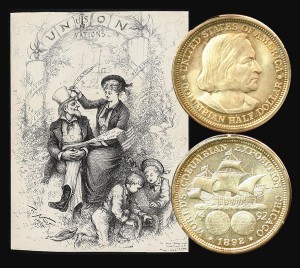Today, the World’s Columbian Commemorative Silver Half Dollar Coin remembers the ceremonies of 1893 when New York welcomed Duke de Veragua, descendent of Columbus, and other dignitaries in celebration of the World’s Columbian Exposition.
Though the Exposition was held in Chicago, New York fêted the visiting delegations with lavish parties.
First, though, the city’s Aldermen voted to welcome the visitors 123 years ago.
From the Proceedings of the Board of Aldermen – New York (N.Y.). Board of Aldermen for April 18, 1893:
=====
By Alderman Owens— Whereas, A reception is to be tendered to the Duke de Veragua, in the Governor’s Room, at 2 o’clock to-day, by the Mayor, Aldermen and Commonalty of the City of New York; therefore be it Resolved, That the Board of Aldermen attend said reception in a body.
The President put the question whether the Board would agree with said resolution. Which was decided in the affirmative.
=====
In the American Magazine of November 1906, John Austen Stevens included highlights from that era in his article, New York in the Nineteenth Century:
=====
The next notable celebration in the city was that originated and carried out by the New York Chamber of Commerce in April, 1893, to commemorate the discovery of America by Columbus.
A committee raised by the Chamber, with the assistance of the state department, sent invitations to every foreign city in which there was an American consulate, tendering the hospitalities of New York to any delegations or individuals they might accredit.
Headquarters were established at the Waldorf, the opening of that magnificent structure occurring at the time.
The Chamber invited the co-operation of the New York Historical and New York Geographical Societies.
The ceremonies were opened by the reception of the duke de Veragua, his lady, and suite, which was followed by an afternoon reception conducted by a hundred ladies of representative New York families old and new, and a hundred gentlemen ushers, with five thousand invited guests gathered to meet the distinguished visitors.
A later ceremony was a banquet given to the visiting admirals and officers of the foreign fleets in our waters.
The Chamber of Commerce conducted these entertainments, which were on a most lavish and elegant scale.
The municipality of the city, aided by a munificent donation of money from the state, also gave a reception and great ball to the representatives of the Spanish crown, the Princess Eulalia, and the duke and duchess and other distinguished guests.
=====
Providing more details, Benson John Lossing added footnotes describing the Duke’s visit in his book, Lossing’s New History of the United States, From the Discovery of the American Continent to the Present Time:
=====
The full name of the Duke, descendant of Christopher Columbus, who in 1893 became the guest of the United States, was Don Christobel Colon de Toledo de la Cerda y Gante, Duke de Veragua, Marquis of Jamaica and Admiral and Adelantado Mayor of the Indies.
The Duke de Veragua, accompanied by his wife and children, his brother. Marquis of Barboles, and private secretary, and others of his party, left Madrid April 2d for the United States, via Paris, London, and the steamer New York.
Commander Francis W. Dickens, U. S. N ., was sent to New York as a representative of the Government to meet the Duke of Veragua.
For this purpose he went on the U. S. cutter Grant down the harbor when the arrival of the ship was announced.
The committee appointed by the Director-General of the World’s Columbian Exposition, and the representatives of the New York committee, and the city officials, went down the harbor on the steamer Blackbird.
Commander Dickens first greeted the Duke of Veragua, speaking to him in Spanish, and after his reply he was again addressed in Spanish by the committee from the Blackbird, and presented with a scroll of welcome.
Then the whole party boarded the Blackbird and steamed up to the foot of West Twenty-second street, whence they were driven to the Hotel Waldorf, where Mayor Gilroy and other officials received them.
The Spanish flag was hung at the Maritime Exchange, also at the balcony opposite the rooms of the Duchess of Veragua.
On April 19th the Duke of Veragua was formally welcomed by the Mayor of the city of New York, and was presented with the freedom of the city, being the fourth person to receive that honor.
Through Commander Dickens and the committee of the city, a reception was held at the Hotel Waldorf.
The house was elaborately and beautifully decorated, and the Atlantic cities were well represented.
Four thousand people paid their respects to the guests of the Nation. Several entertainments followed, when the guests departed for Washington.
There they attended mass, and called at the Spanish Legation. The Duke and Duchess of Veragua received the calls of members of the Cabinet, their wives and representatives, and they dined with Mr. and Mrs. Carlisle and the Spanish Minister and Mrs. Muruagua.
On April 24th the ducal party called at 3 o’clock on the President and Mrs. Cleveland. They were received in the Blue room.
The simple suit of the President contrasted with the brilliant uniforms of the party.
Commander Dickens represented the Government of the United States, and an attaché of the Spanish Minister that of Spain.
April 26th, the party returned to New York, and on the 28th left for Chicago.
=====
The World’s Columbian Commemorative Silver Half Dollar Coin shows with a patriotic image from New York, April 1893, showing the Union of All Nations – the Great Navy Review.
